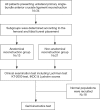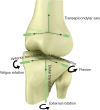In vivo gait kinematics of the knee after anatomical and non-anatomical single-bundle anterior cruciate ligament reconstruction-a prospective study
- PMID: 32042815
- PMCID: PMC6989884
- DOI: 10.21037/atm.2019.12.71
In vivo gait kinematics of the knee after anatomical and non-anatomical single-bundle anterior cruciate ligament reconstruction-a prospective study
Abstract
Background: The factors that influence functions of knees after anterior cruciate ligament reconstruction (ACLR) still remains uncertain. The functional restoration of knees after ACLR can be reflected on gait kinematics restoration. The purpose of this study was to evaluate the gait kinematics and clinical outcomes of knees after anatomical and non-anatomical single-bundle ACLR during level walking.
Methods: Thirty-four patients with unilateral primary single-bundle ACLR and 18 healthy people were recruited. Patients were divided into anatomical reconstruction group (AR group; n=13) and non-anatomical reconstruction group (Non-AR group; n=21) according to Bernard Quadrant method. The ACL graft orientations on coronal and sagittal planes were measured on 3D models from medical images. The 6 degrees of freedom (DOF) kinematics of knees and range of motion (ROM) of 6 DOF kinematics were measured with a portable optical tracking system. The comparison of 6 DOF kinematics and ROM of 6 DOF kinematics were performed between the ACLR knees and contralateral knees. The following assessments were also performed including clinical examination, KT-2000 arthrometer measurement, International Knee Documentation Committee (IKDC) and Lysholm scores.
Results: All patients reached a minimum follow-up of 6 months (10±4 months). For AR group and Non-AR group, no statistically significant differences were observed in gait kinematics between the ACLR knees and contralateral knees. No statistically significant differences between the ACLR knees and contralateral knees were observed in terms of ROM of 6 DOF kinematics in AR group. However, in Non-AR group, the ACLR knees exhibited significant ROM of anterior-posterior translation by approximately 0.5 cm than contralateral knees (P=0.0080). No statistically significant differences between the two groups were observed regarding IKDC subjective score, Lysholm score and KT-2000 arthrometer test.
Conclusions: The anatomical ACLR can restore close to normal gait kinematics and ROM of 6 DOF kinematics compared with non-anatomical ACLR. The ACL graft after anatomical ACLR simulated native ACL fibers to function in terms of graft orientation.
Keywords: Anatomical anterior cruciate ligament reconstruction (ACLR); anterior cruciate ligament graft orientation; knee kinematics; non-anatomical reconstruction (non-AR); single-bundle.
2019 Annals of Translational Medicine. All rights reserved.
Conflict of interest statement
Conflicts of Interest: The authors have no conflicts of interest to declare.
Figures









References
LinkOut - more resources
Full Text Sources
Research Materials
